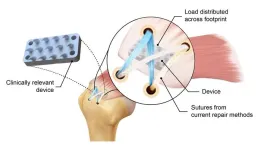(Press-News.org) An A-list of researchers from across USC is building a dementia cost model that will generate comprehensive national, annual estimates of the cost of dementia that could benefit patients and their families, thanks to a five-year, $8.2 million federal grant from the National Institute on Aging.
A firm grip on the costs of the disease could assist families living with dementia with planning their budgets and support needs, inform treatment and caregiving options, and help shape health care policy.
“We currently have estimates for a particular set of costs, but we’ve learned those estimates don’t encompass nearly all the costs to the person with dementia, their family and to society,” said Julie Zissimopoulos, a professor at the USC Price School of Public Policy and the USC Schaeffer Center for Health Policy & Economics, who is leading the project. “Everything about this disease affects the family’s pocketbook.”
Dementia costs can be catastrophic for families, depleting savings and pressing caregivers to leave their jobs. The condition imposes a staggering economic burden on the United States as a whole. This year, total health care and long-term care costs for individuals with Alzheimer's or other dementias are projected to reach $360 billion, and may soar to nearly $1 trillion by 2050, the Alzheimer’s Association projects.
“Other consequences may include caregivers’ lower retirement savings or limited ability to send their children to college,” said project advisor Maria Aranda, a professor at the USC Suzanne Dworak-Peck School of Social Work who studies the impact of Alzheimer’s on Black and Latino families. “In turn, this leads to an intergenerational transmission of inequality and financial vulnerability for families of persons with dementia.”
The tool, known as a “dynamic microsimulation model,” will incorporate multiple data sets including data from the Centers for Medicare & Medicaid Services and national surveys on aging Americans such as the Health and Retirement Study. The model will account for costs across a range of disease stages, including those accrued by the person living with dementia, their care partners and caregivers, and even their payers. In addition, the model’s estimates will adjust for prevention and treatment innovations.
The research team is co-led by Dana Goldman, who will become the director of the new USC Schaeffer Institute for Public Policy & Government Service on July 1 after having served as the dean of the USC Price School for the past four years. The A-team also includes experts from:
Keck School of Medicine of USC.
USC Alfred E. Mann School of Pharmacy and Pharmaceutical Sciences.
USC Leonard Davis School of Gerontology.
USC Suzanne Dworak-Peck School of Social Work.
USC Viterbi School of Engineering.
“Once you factor in the social costs of Alzheimer’s — how it affects family, caregivers and others — you quickly realize it is not just an illness but a social epidemic,” Goldman said. “This project will help amplify the importance of finding treatments that forestall the devastation.”
Patients and caregivers are among the experts who will advise on the project. Other advisors include representatives of the Alzheimer’s Association, UCLA, the University of Pennsylvania and the Los Angeles County Department of Public Health.
USC Viterbi scientists will design an interface so that the tool, which will be publicly available, is user-friendly.
In addition to providing up-to-date and comprehensive annual estimates, researchers will be able to calculate, for example, the social and economic impact of drugs that treat the neuropsychiatric symptoms associated with advanced dementia — and keep patients out of hospitals and emergency rooms. The tool might also measure cost savings provided by a new drug with modest benefit, but which delays by two months the expense of 24-hour care.
“Leqembi is a great example. It’s a new FDA-approved treatment for early-stage Alzheimer’s; we have data from clinical trials that informs patients and the health care providers about safety and efficacy, ” Zissimopoulos said. “But these data are not informative about the other outcomes patients and their families care about including quality of life impacts that may result from this slowing of cognitive decline. And we want to know about not just the 18 months of the clinical trial, but we want to know about them for 10 years, for 20 years.
“With the infrastructure that we’re building, we’ll be able to understand better what is the value and for whom.”
# # #
END
Dementia cost calculator will provide precise, annual, national estimates of Alzheimer's financial toll
Dynamic microsimulation model to incorporate huge data sets as well as lived experience
2024-06-28
ELSE PRESS RELEASES FROM THIS DATE:
Moffitt researchers develop synthesis method to enhance access to cancer-fighting withanolides
2024-06-28
TAMPA, Fla. — Withanolides, a class of naturally occurring compounds found in plants, have long been a focus of cancer research due to their ability to inhibit cancer cell growth, induce cell death and prevent metastasis. These compounds are important in developing new cancer treatments. However, the difficulty of obtaining enough of these compounds from plants has hindered research and therapeutic development.
Moffitt Cancer Center researchers have developed a groundbreaking method for the scalable synthesis of withanolides. This innovative approach, published in Science Advances, could revolutionize cancer research by providing ...
Analysis of NASA InSight data suggests Mars hit by meteoroids more often than thought
2024-06-28
PROVIDENCE, R.I. [Brown University] — NASA’s Mars InSight Lander may be resting on the Red Planet in retirement, but data from the robotic explorer is still leading to seismic discoveries on Earth.
In one of the latest studies using data from the spacecraft, an international team of scientists led by a Brown University researcher found that Mars may be getting bombarded by space rocks at more frequent rates than previously thought. Impact rates could be two to 10 times higher than previously estimated, depending on the size of the meteoroids, according to the study published in Science Advances.
“It’s ...
Serotonin 2C receptor regulates memory in mice and humans – implications for Alzheimer’s disease
2024-06-28
Researchers at Baylor College of Medicine, the University of Cambridge in the U.K. and collaborating institutions have shown that serotonin 2C receptor in the brain regulates memory in people and animal models. The findings, published in the journal Science Advances, not only provide new insights into the factors involved in healthy memory but also in conditions associated with memory loss, like Alzheimer’s disease, and suggest novel avenues for treatment.
“Serotonin, a compound produced by neurons in the midbrain, acts as a neurotransmitter, passing messages between brain cells,” said co-corresponding author Dr. Yong Xu, professor of pediatrics ...
New device inspired by python teeth doubles strength of rotator cuff repairs
2024-06-28
New York, NY—June 24, 2024—Most people, when they think about pythons, visualize the huge snake constricting and swallowing victims whole. But did you know that pythons initially hold onto their prey with their sharp, backward-curving teeth? Medical researchers have long been aware that these teeth are perfect for grasping soft tissue rather than cutting through it, but no one has yet been able to put this concept into surgical practice. Over the years, mimicking these teeth for use in surgery has been a frequent topic ...
The beginnings of fashion
2024-06-28
EMBARGO: 4:00 Sydney AEST June 29 | 14:00 US ET June 28 2024
The beginnings of fashion
Paleolithic eyed needles and the evolution of dress
A team of researchers led by an archaeologist at the University of Sydney are the first to suggest that eyed needles were a new technological innovation used to adorn clothing for social and cultural purposes, marking the major shift from clothes as protection to clothes as an expression of identity.
“Eyed needle tools are an important development in prehistory because they document a transition in the function of clothing from utilitarian to social purposes,” says Dr Ian Gilligan, Honorary Associate ...
Why some tumors are resistant to cell therapies
2024-06-28
FRANKFURT. In congratulating the CARISMa scientists, Goethe University President Prof. Enrico Schleiff said: “The new LOEWE network sets up in Hesse an innovative research program that is currently gathering steam all over the world. It also expands Goethe University’s existing research profile and broadens our network of cooperation partners in the field of CAR cell therapy [editor’s note: CAR is the abbreviation for chimeric antigen receptor]. The network deliberately builds on our university’s ...
Can A.I. tell you if you have osteoporosis? Newly developed deep learning model shows promise
2024-06-28
Osteoporosis is so difficult to detect in early stage it’s called the “silent disease.” What if artificial intelligence could help predict a patient’s chances of having the bone-loss disease before ever stepping into a doctor’s office?
Tulane University researchers made progress toward that vision by developing a new deep learning algorithm that outperformed existing computer-based osteoporosis risk prediction methods, potentially leading to earlier diagnoses and better outcomes for patients with osteoporosis risk.
Their results were recently published in ...
Work-related nerve injuries are common with repetitive motions
2024-06-28
Although you may not always realize it, many of the jobs you do can put strain on, and even cause damage to, your nerves.
Sandra Hearn, M.D., the associate chair of Education and Professional Development in the Department of Physical Medicine and Rehabilitation, and a team of collaborators, set out to better understand the causes of occupational nerve injuries.
What is an occupational nerve injury?
An occupational nerve injury refers to a problem with your peripheral nerves that's caused by a work-related activity. It's often seen ...
Mount Sinai study reveals significant differences in RNA editing between postmortem and living human brain
2024-06-28
Researchers from the Icahn School of Medicine at Mount Sinai have shed valuable light on the nuanced functions and intricate regulatory methods of RNA editing, a critical mechanism underlying brain development and disease.
In a study published June 26 in Nature Communications, the team reported finding major differences between postmortem and living prefrontal cortex brain tissues as they relate to one of the most abundant RNA modifications in the brain, known as adenosine-to-inosine (A-to-I) editing. This discovery will play a significant role ...
Penn researchers will investigate link between TBI and dementia with $10M NIH grant
2024-06-28
PHILADELPHIA— A team of researchers led by Penn Medicine will investigate the link between traumatic brain injuries (TBI) and Alzheimer’s disease and related dementias (ADRD) over the next five years with a $10 million grant from the National Institute of Neurological Disorders and Stroke (NINDS). Using an extensive tissue bank including over 1,000 samples, the researchers aim to uncover the underlying biological mechanisms of TBI-related neurodegeneration (TReND) from a variety of brain injury types. ...
LAST 30 PRESS RELEASES:
Tracing the quick synthesis of an industrially important catalyst
New software sheds light on cancer’s hidden genetic networks
UT Health San Antonio awarded $3 million in CPRIT grants to bolster cancer research and prevention efforts in South Texas
Third symposium spotlights global challenge of new contaminants in China’s fight against pollution
From straw to soil harmony: International team reveals how biochar supercharges carbon-smart farming
Myeloma: How AI is redrawing the map of cancer care
Manhattan E. Charurat, Ph.D., MHS invested as the Homer and Martha Gudelsky Distinguished Professor in Medicine at the University of Maryland School of Medicine
Insilico Medicine’s Pharma.AI Q4 Winter Launch Recap: Revolutionizing drug discovery with cutting-edge AI innovations, accelerating the path to pharmaceutical superintelligence
Nanoplastics have diet-dependent impacts on digestive system health
Brain neuron death occurs throughout life and increases with age, a natural human protein drug may halt neuron death in Alzheimer’s disease
SPIE and CLP announce the recipients of the 2025 Advanced Photonics Young Innovator Award
Lessons from the Caldor Fire’s Christmas Valley ‘Miracle’
Ant societies rose by trading individual protection for collective power
Research reveals how ancient viral DNA shapes early embryonic development
A molecular gatekeeper that controls protein synthesis
New ‘cloaking device’ concept to shield sensitive tech from magnetic fields
Researchers show impact of mountain building and climate change on alpine biodiversity
Study models the transition from Neanderthals to modern humans in Europe
University of Phoenix College of Doctoral Studies releases white paper on AI-driven skilling to reduce burnout and restore worker autonomy
AIs fail at the game of visual “telephone”
The levers for a sustainable food system
Potential changes in US homelessness by ending federal support for housing first programs
Vulnerability of large language models to prompt injection when providing medical advice
Researchers develop new system for high-energy-density, long-life, multi-electron transfer bromine-based flow batteries
Ending federal support for housing first programs could increase U.S. homelessness by 5% in one year, new JAMA study finds
New research uncovers molecular ‘safety switch’ shielding cancers from immune attack
Bacteria resisting viral infection can still sink carbon to ocean floor
Younger biological age may increase depression risk in older women during COVID-19
Bharat Innovates 2026 National Basecamp Showcases India’s Most Promising Deep-Tech Ventures
Here’s what determines whether your income level rises or falls
[Press-News.org] Dementia cost calculator will provide precise, annual, national estimates of Alzheimer's financial tollDynamic microsimulation model to incorporate huge data sets as well as lived experience


